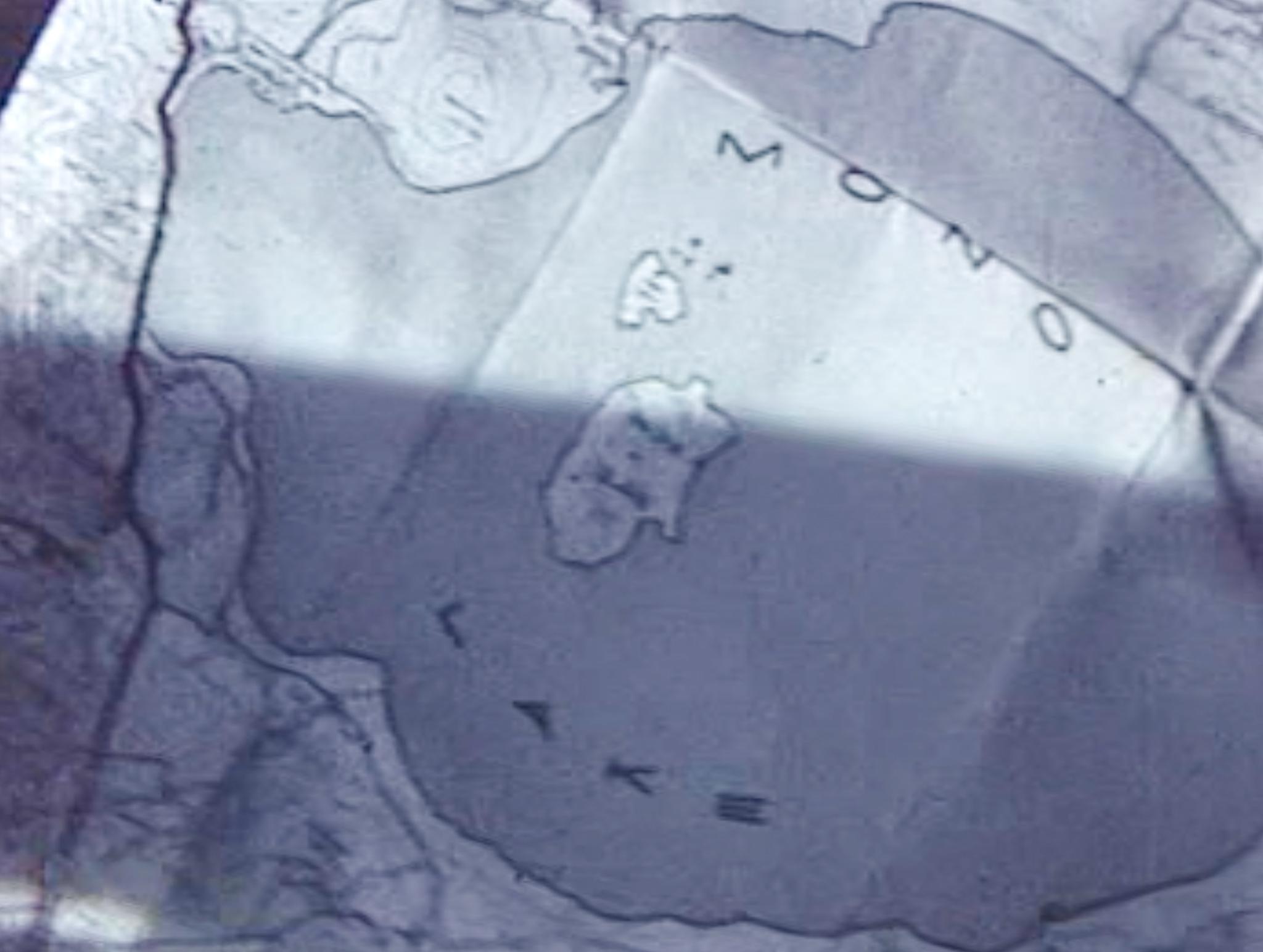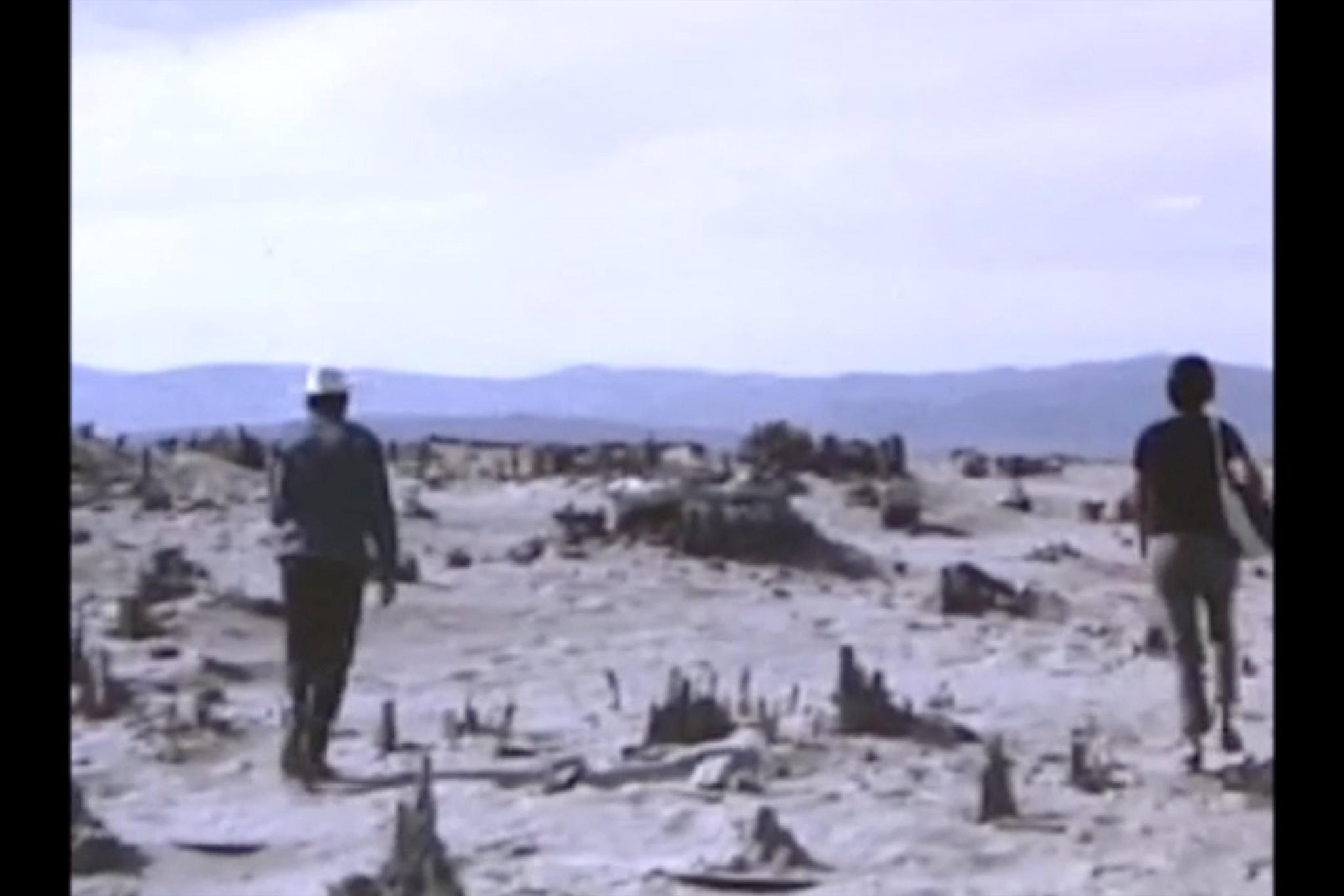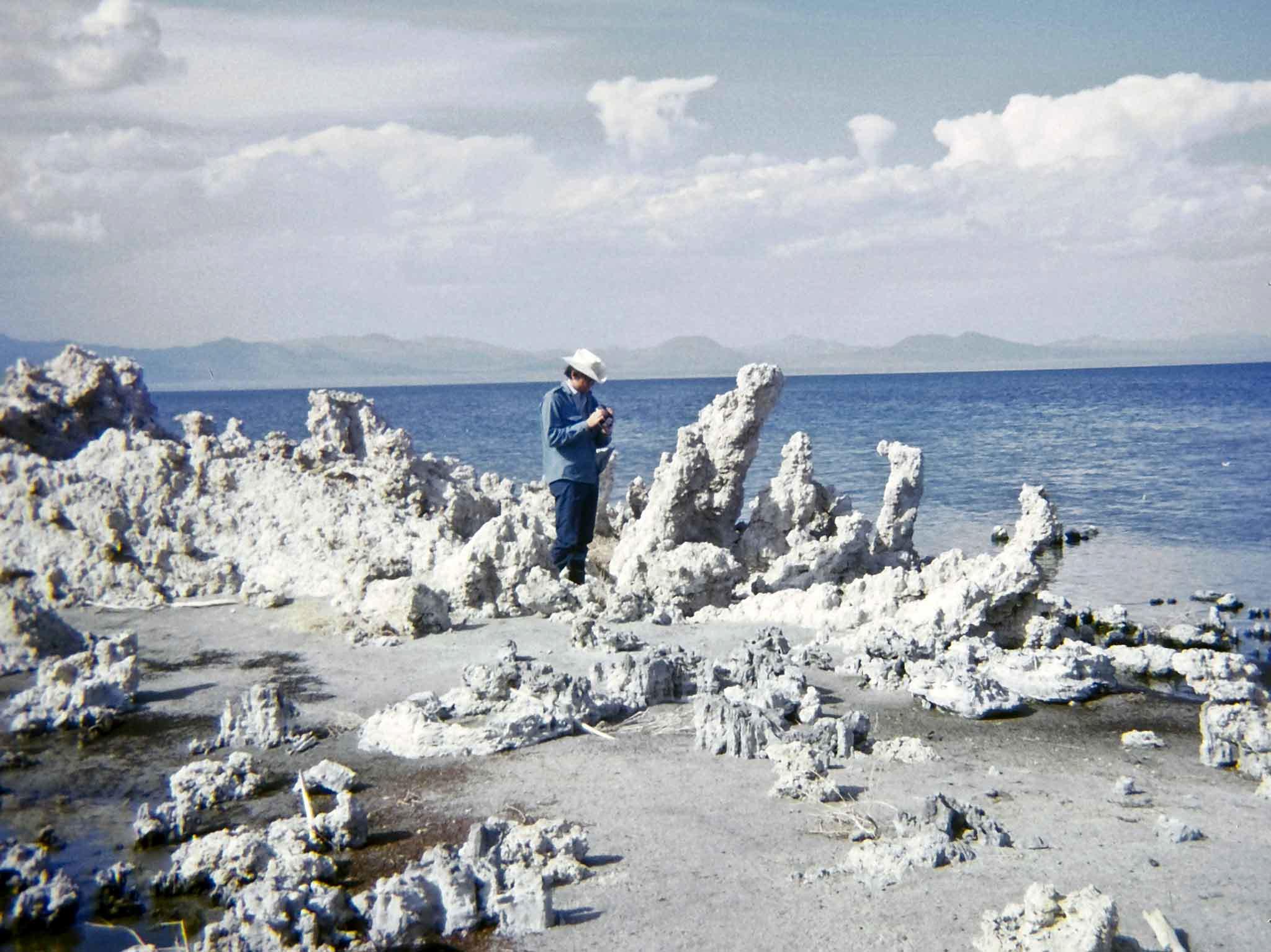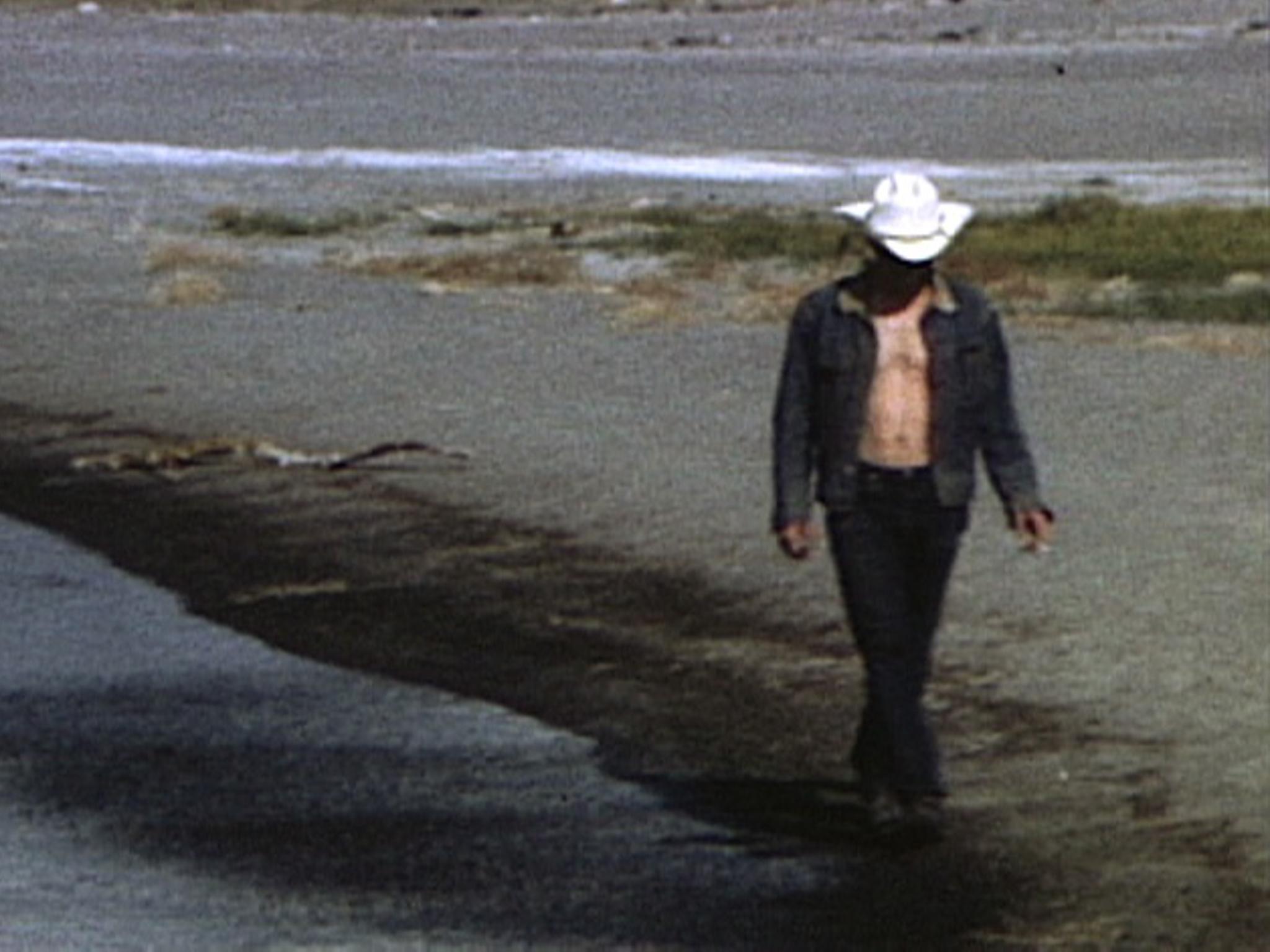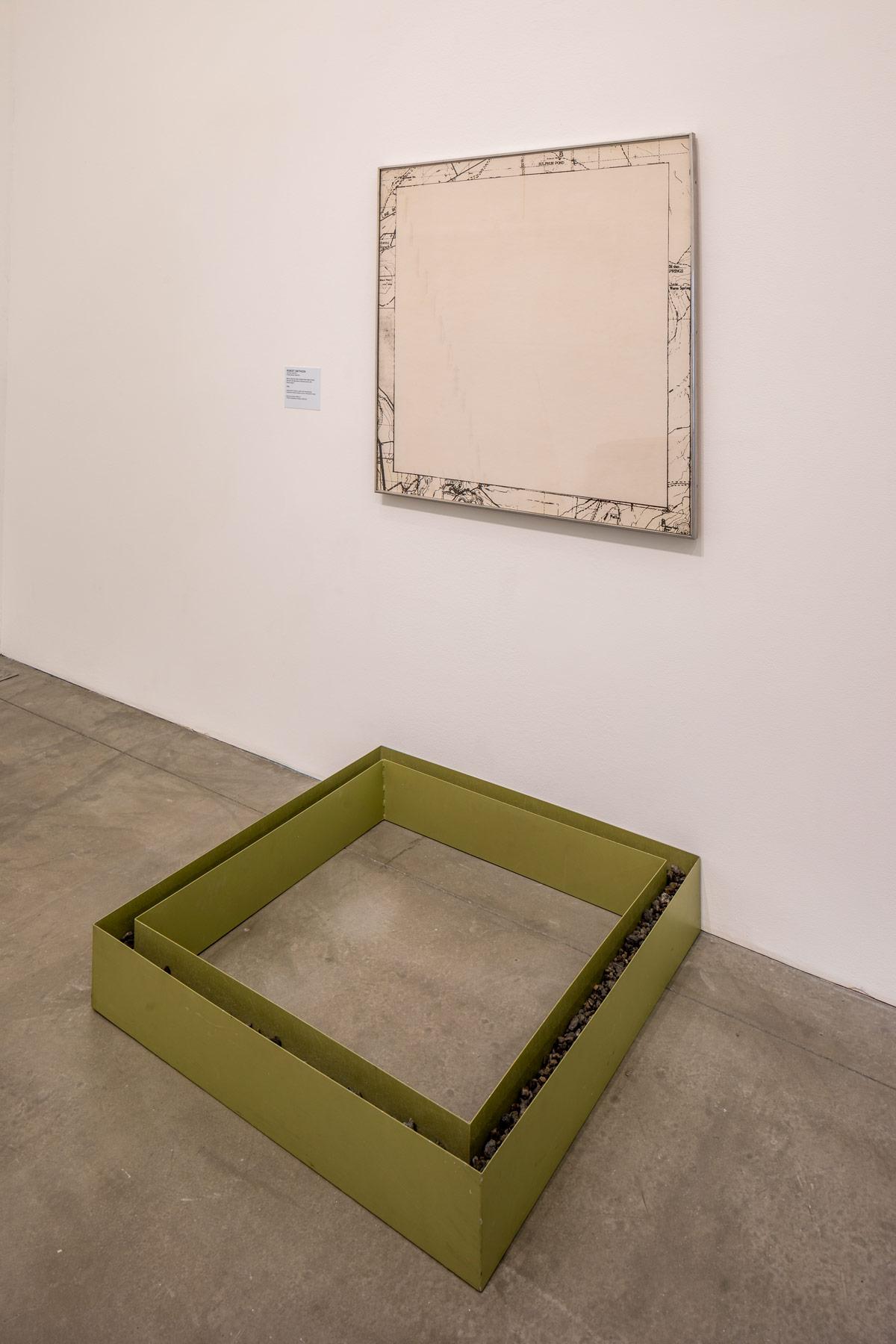Mono Lake: Ring of Fire
At any location on earth, as the rock record goes down into time and out into earlier geographies it touches upon tens of hundreds of stories, wherein the face of the earth often changed, changed utterly, and changed again, like the face of a crackling fire.1
–John McPhee
Mono Lake opens in dramatic flames set to a cinematic soundtrack by Michel Legrand, before transporting viewers to the gravel roads of the Eastern Sierra. The film was shot on July 28, 1968 by Nancy Holt, Robert Smithson, and Michael Heizer, and edited by Holt in 2004. We join the artists on a road trip through the “frost and fire” glacial and volcanic landscape, to Mono Lake, an ancient lake in the Basin and Range.2 Mono Lake serves as a portal to this curious landscape, shot during a pivotal time for each of the artists, and for the United States. In 1968, while seismic social and political shifts were underway across the country, cultural boundaries were also changing, and Holt, Smithson, and Heizer were forging new artistic terrain.
At the time of the Mono Lake journey onsite fieldwork and the tour, script, and travelogue format were becoming central to both Holt and Smithson’s work. Starting in 1967 Holt led numerous field trips with Smithson and other friends, often photographing the outings, and experimenting with the guided tour as a creative framework for understanding place.3 Between 1966 and 1968 Smithson also organized frequent excursions, with Holt and others, to scout sites and collect materials for various Nonsite works.4 The trio’s excursion to Mono Lake was part of a two-month trip through California and Nevada.5 Its significance is noted in Holt and Smithson’s texts for both Sun Tunnels (1973–76) and Spiral Jetty (1970), their most cited artworks. This 1968 trip marked Holt’s first travels to the Western states,6 and Smithson notes the visit to Mono Lake sparking his interest in salt lakes.7 Mono Lake serves as a record of a period when each of the three artists would experience profound developments in their practices.
Arriving in Las Vegas Holt, Smithson, and Heizer would spend several weeks on the road, working on projects in the physical landscape, often assisting each other with the creation of what would become important artworks, while also taking time for recreation.8 Holt and Smithson documented, and participated in, the construction of Rift 1 (1968), the first of Heizer’s Nine Nevada Depressions, at Jean Dry Lake. Holt was starting to shoot film in the landscape, to both document activities, and to explore and understand her environs. She worked on the Western Graveyards (1968) photographic series in Lone Pine, California and Virginia City, Nevada. The artists visited Baker, Kelso, and Montgomery Pass as they traveled though the Basin and Range, collecting lava and obsidian for Smithson’s Double Nonsite, California and Nevada (1968–69). They stopped in a geothermal area near Benton, gathering material for Smithson’s Gypsum Nonsite, Benton, California (1968).9 Smithson’s interest in the volcanic led the group to Mono Lake. Here they sourced cinders for a Nonsite, and shot footage for a loosely planned film. While Mono Lake documents the process of making Mono Lake Nonsite (Cinders Near Black Point) (1968), it offers a candid glimpse into the artists’ collaborative approach to fieldwork. Shot with the informality of a home movie, Holt, Smithson, and Heizer are shown as impetuous and affable, enjoying one another’s company as much as the remarkable landscape.
On the road, the trio are our guides. Reciting excerpts from a regional rockhounding reference Smithson and Heizer provide anthropological, geographical, and geological context into the local environs.10 Outlaw country music on the radio, a cigarette in hand, downing a beer, equipped with cameras and maps as tools, and donning sunglasses, cowboy boots, and hats—Mono Lake conjures a stereotypical portrayal of youth and the American road trip in the late 1960s, not so unlike Easy Rider (1969) or Zabriskie Point (1970). The intense heat, aridity, and pungency of the lake on a summer day is palpable. The camera pans over the fly-infested, salty shoreline, buzzing and lapping waters audible, transporting viewers to Mono Lake. Exploring the site through the artists’ eyes, we share their delight in the crusty calcium carbonate tufa, evocative of classical architecture. We can almost feel the incessant blanket of flies skim our limbs, impossible to displace, when walking along the shoreline.
The group makes their way to the lake’s north shore, to Black Point, where an underwater volcano erupted over 13,300 years ago, forming basaltic cinder masses. “One step up, and slide back two,” Smithson reads. Testing man’s potential to cause geologic change, Heizer trudges up a cinder mound, prompting a mini avalanche of rubble with each step, only to tumble down.11 We end the day, and film, around a campfire in Lake Tahoe, north of Mono Lake on U.S. Route 395. Roasted marshmallows are prodded and dragged across a map of Nevada.12 The camera closes in on the tacky mess, while lit matches are thrown onto the distorted map. Flames quickly burn the map from the center, extending outward, until all that remains is a field of black ash. Onscreen text informs viewers that these ashes are used in Smithson’s Mono Lake Nonsite.13
While Mono Lake largely reads as a linear narrative, it is a loop, starting and ending in the same place. This cyclical format and concern for the circular recurs throughout Holt’s work.14 The film offers a poly-temporal vision of the site, bringing together a range of sources—anthropological, geological, cultural, and personal—without turning to disorienting filmic montage as device, as Smithson used in his 1970 Spiral Jetty film. Viewers embark on a journey to Mono Lake on a 1968 summer day, and simultaneously to Mono Lakes of years past and towards visions of future Mono Lakes. Edited by Holt more than three decades after it was shot, Mono Lake is a collaboration with Smithson as well as with Holt’s younger self; it is, to use Holt’s words, a “collaboration through time”15 offering a personal reflection on a pivotal period of her life. Holt manipulates time, freezing on certain moments by inserting still slide frames, the pauses emphasized by the camera shutter’s clicks. Like geologists, the artists guide viewers between different timescales, invoking the ancient lake throughout its history. Mono Lake, like much of Holt and Smithson’s work, can be seen as a tool for reframing the way we think about ourselves in time and place.16
Mono Lake is a terminal lake, or endorheic basin. Like a bathtub with no drain, water pools and exits only by evaporation, leaving behind salty deposits. This results in a saline lake with shifting levels and shorelines, often further impacted by human intervention. In the 1940s, the Los Angeles Department of Water and Power diverted the creeks that fed into Mono Lake to support the city of Los Angeles, leading to the “slow impoverishment of a bizarre but prolific ecosystem, accelerating… towards collapse.”17 While conservation efforts have since brought some flow back to the lake to prevent further sinking, the landscape has not truly stabilized, and likely never will. The basin is alive, in constant movement.18 In the Basin and Range the earth’s history is particularly legible: the dry lakebeds, faults, cinder cones, and lava flows are physical evidence of the previous worlds embedded in the one we live in today. The film’s narration suggests reverence for this layered history, yet cultural cues precisely date the footage to 1968—there is the car and its license plate, the radio tunes, the artists’ attire, and the onscreen text at the end of the film. Mono Lake’s conclusion, on a black frame, might be read as an opening, conjuring the site’s possible futures.
Holt has described deserts as timeless landscapes. Returning to the West a few years later to create Sun Tunnels (1973–76) near the shores of the Great Salt Lake, another terminal lake, she writes:
'Time' is not just a mental concept or a mathematical abstraction in the desert. The rocks in the distance are ageless; they have been deposited in layers over hundreds of thousands of years. 'Time' takes on a physical presence…Out there a 'lifetime' seems very minute…I had a strong sense that I was linked through thousands of years of human time with the people who had lived in the caves around there for so long. I was sharing the same landscape with them.19
Holt’s deep consideration of our planet’s timescales is apparent in Mono Lake. Writing in 2018 geology professor Marcia Bjornerud refers to the acute consciousness that the world is made by and of time as timefulness. She suggests expanding our comprehension of time is useful, and necessary, for confronting the overwhelming and overlapping rates of change in the Anthropocene.20
The physical surface of our planet is without question changing. A new zone of geological instability has been observed emerging along the length of the Eastern Sierra. Some geologists predict this network of faults, known as the Walker Lane, may become the definitive plate boundary in the West if the San Andreas Fault, the sliding boundary between the Pacific Plate and the North American Plate, goes dormant after severely drifting out of alignment. The Walker Lane largely follows U.S. Route 395, and it could potentially become the new western edge of the continent.21 Mono Lake, at the center of the Walker Lane stretch, would then go from being an inland terminal lake, to being coastal land. The center would become the periphery.
“Stop the world and let me off. I’m tired of going round and round,” Waylon Jennings croons on the soundtrack, as the trio departs Mono Lake, and the film begins to wind down. The earth is constantly spinning. As the world turns, it shifts—physically, culturally, politically, and socially. It may seem that each year the spinning is getting faster and faster. How can we contend with these immense and rapid movements? Perhaps some understanding can be gleaned in pause, rewind, fast-forward, repeat.
Selected Bibliography
Bjornerud, Marcia. Timefulness. Princeton and Oxford: Princeton University Press, 2018.
Flam, Jack, ed. Robert Smithson: The Collected Writings. Berkeley: University of California Press, 1996.
Hart, John. Storm Over Mono: The Mono Lake Battle and the California Water Future. Berkeley and Los Angeles: University of California Press, 1996.
Hobbs, Robert, ed. Robert Smithson: Sculpture. Ithaca and London: Cornell University Press, 1981.
Loe, Hikmet Sidney. The Spiral Jetty Encyclo. Salt Lake City: University of Utah Press, 2017.
Manaugh, Geoff. “Move Over, San Andreas: There’s an Ominous New Fault in Town.” Wired, April 18, 2019. https://www.wired.com/story/walker-lane-move-over-san-andreas-fault/.
McPhee, John. Basin and Range. New York: Farrar, Straus and Giroux, 1981.
Williams, Alena J., ed. Nancy Holt: Sightlines. Los Angeles: University of California Press, 2011.
About the Author
Aurora Tang is a curator and researcher based in Los Angeles. Since 2009 she has been a program manager at The Center for Land Use Interpretation. From 2011–15 she was managing director of High Desert Test Sites. Tang has taught at Otis College of Art and Design and the University of Southern California, and is faculty at the Southland Institute. She is on the board of directors of Common Field.
- 1John McPhee, Basin and Range (New York: Farrar, Straus and Giroux, 1981), 36.
- 2The Basin and Range is a physiographic province in the western and southwestern United States that encompasses almost all of the state of Nevada, the western half of Utah, southeastern California, the southern part of Arizona, extending into northwestern Mexico.
- 3For Holt’s brief account of the July 1968 trip, and other excursions, including Stone Ruin Tour (1967), the first of her Tours works, see James Meyer, “Interview with Nancy Holt,” in Nancy Holt: Sightlines, ed. Alena J. Williams (Los Angeles: University of California Press, 2011), 222.
- 4For more on these trips see Lawrence Alloway, “Sites/Nonsites,” in Robert Smithson: Sculpture, ed. Robert Hobbs (Ithaca and London: Cornell University Press, 1981), 41–42. A timeline of Smithson’s activities during these years, including excursions with colleagues and friends, is outlined in Hobbs, Robert Smithson: Sculpture, 235–237.
- 5For a rough itinerary of the trip, from Smithson’s datebook, see Emily Eliza Scott, “Elsewhere: Desert Ends,” in Ends of the Earth: Land Art to 1974, eds. Philipp Kaiser and Miwon Kwon (London: Prestel Munich, 2012), 84.
- 6Holt writes “I went out West for the first time in 1968 with Robert Smithson and Michael Heizer. As soon as I got to the desert I connected with the place. Before that, the only other place that I had felt in touch with in the same way was the Pine Barrens in southern New Jersey, which only begins to approach that kind of Western spaciousness.” Nancy Holt, “Sun Tunnels,” Artforum 15, no. 1 (April 1977): 32–37.
- 7Robert Smithson, “The Spiral Jetty” (1972), in Robert Smithson: The Collected Writings, ed. Jack Flam (Berkeley: University of California Press, 1996), 143.
- 8Holt, Smithson, and Heizer had already taken trips together outside of New York City, including to Franklin Mineral Dump, on June 14, 1968, just weeks before their trip out West.
- 9The photographs from the July 1968 trip are categorized in Holt’s photographic inventory as “Searching for Lava + Pumice + Cleaning Truck.” See Ines Schaber, “The Claims She Stakes: A Reading of Nancy Holt’s Archive,” in Williams, Nancy Holt: Sightlines,167. Smithson describes his volcanic interests in “Four Conversations Between Dennis Wheeler and Robert Smithson” (1969–70), in Flam, Robert Smithson: The Collected Writings, 219–220.
- 10Mono Lake film credits, as compiled by Holt, cite the 1967 booklet Rock Hounding Out of Bishop, by Cora B. Houghtaling, as a source for the film’s script. Hikmet Loe suggests Kutsavi: A Great Basin Indian Food (1950), by Robert Heizer, was an additional source. Robert Heizer, Michael Heizer's father, was a noted anthropologist, who studied the Indigenous cultures of California and Nevada. The July 1968 trip included a visit to Robert Heizer’s cabin in Lake Tahoe. See Hikmet Loe, The Spiral Jetty Encyclo (Salt Lake City: University of Utah Press, 2017), 30.
- 11In an interview with Gianni Pettena in 1972 Smithson writes, “I like landscapes that suggest prehistory. As an artist it is sort of interesting to take on the persona of a geologic agent where man actually becomes part of that process rather than overcoming it—rather than overcoming the natural processes of challenging the situation.” See “Conversation in Salt Lake City” (1972), in Flam, Robert Smithson: The Collected Writings, 298. This ascent, descent, and displacement of cinders shares some overlaps with Holt’s photographic works Over the Hill (Joan Jonas) and Down Hill (Joan Jonas) (1968). These might be viewed as a precedent to Smithson’s outdoor flow works, starting with Asphalt Rundown in 1969.
- 12This use of marshmallow is evocative of the viscous materials that Smithson would use in his flow works, such as mud, muck, asphalt, and glue.
- 13Smithson describes Mono Lake, including the significance of the center in relation to the fringes, and the Site and Nonsite, in “Four Conversations Between Dennis Wheeler and Robert Smithson” (1969–70), 219–222.
- 14Several of Holt’s works, including The World Through a Circle (1972), Sun Tunnels (1973–76), Stone Enclosure: Rock Rings (1977–78), and Solar Rotary (1995), call attention to the earth’s cyclical rotations.
- 15Meyer, “Interview with Nancy Holt,” 224.
- 16Smithson embraced art’s potential to “not only communicate[s] through space, but also through time.” Robert Smithson, “The Artist as Site-Seer; or, a Dintorphic Essay” (1966–67), in Flam, Robert Smithson: Collected Writings, 342.
- 17Hart, John, Storm Over Mono: The Mono Lake Battle and the California Water Future (Berkeley and Los Angeles: University of California Press, 1996), 2.
- 18 “The earth is moving. The faults are moving. There are hot springs all over the province. There are young volcanic rocks. Fault scars everywhere. The world is splitting open and coming apart,” John McPhee writes of the region. McPhee, Basin and Range, 51.
- 19Holt, “Sun Tunnels,” 32-37.
- 20Marcia Bjornerud, Timefulness (Princeton and Oxford: Princeton University Press, 2018), 5.
- 21Geoff Manaugh, “Move Over, San Andreas: There’s an Ominous New Fault in Town,” Wired, April 18, 2019, https://www.wired.com/story/walker-lane-move-over-san-andreas-fault/ [accessed June 16, 2020].
Tang, Aurora. "Mono Lake: Ring of Fire." Holt/Smithson Foundation: Scholarly Texts Chapter 1 (June 2020). https://holtsmithsonfoundation.org/mono-lake-ring-fire.
